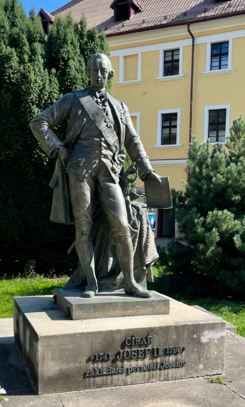
UNC History Ph.D Student Kevin Hoeper had an exciting journey to Czechia, where he attended a conference entitled: “Army, Society, and Warfare in the Bohemian Lands under the Habsburgs (1526-1918).” This conference was organized by an interdisciplinary team of European scholars working on different eras of Habsburg military history, focusing on what is modern-day Czechia. Kevin’s scholarship examines the history of the regiment in Habsburg service: “From the birth of the Habsburg standing army until its dissolution in 1918, the regiment was the army’s most basic administrative structure and the center of military life for soldiers and officers. It is thus an exceptional analytical lens through which to observe continuities and ruptures in Habsburg military culture across the centuries.”
At this conference, Kevin was able to communicate with scholars of different backgrounds: “One of the main impulses behind the conference was to transcend the temporal and thematic barriers that tend to silo scholars in the field of Habsburg and Bohemian military history. There is robust scholarship on the early-modern period, Napoleonic era, and modern period, but I get the sense that these scholars don’t always talk to each other. There are also often thematic barriers between those who pursue more ‘traditional’ military history (focused on wars, battles, campaigns, logistics, tactics, etc.) and those who take a more social- or cultural-historical approach. The organizers” Kevin states “did an excellent job of constructing a program that represented all of these myriad focuses and approaches.”
The topics of the different panels reflected this effort to challenge researchers’ paradigms. “Each was centered around a specific theme — many of them quite creative — that encouraged the audience to see the common scholarly concerns that connect our temporal subfields. For example, a panel on “New Archival Case Studies” included three talks: one each dealing with the late 17th century, the Napoleonic wars, and the First World War.”
This meeting, moreover, introduced Kevin to different ways of conceptualizing his research: “While my work focuses primarily on the modern period (think 19th century to World War I, as well as the post-1918 Habsburg successor states), I have by necessity needed to engage with scholarship on the regiment’s role in earlier periods. By allowing me to interact with historians who specialize in these earlier periods, the conference gave me a far greater appreciation for the questions, concerns, and challenges that shape those subfields. I was also able to ask a few technical questions about early-modern and Napoleonic-era Habsburg regiments that are relevant to my own arguments.”

Kevin also enjoyed the conference’s location in the Czech city of Pardubice, located about an hour east of Prague. “Earlier, during my research year in 2019-20, I had been able to visit some three dozen towns and cities across the Czech Republic but had not visited Pardubice. Part of the conference program included a guided historical tour through the old town, during which we were treated to the city’s many late medieval, renaissance, and Baroque landmarks. Pardubice’s crown jewel is of course its castle. Built in stages from the 13th century by the Pernštejn family, the castle is intimately connected with the pre-Habsburg history of the Bohemian lands. The conference panels actually took place each day in the castle’s great hall; listening to brilliant scholars teach me about their work in the central hall of a beautifully maintained castle is an experience I will never forget.”
“After two days of panels at Pardubice castle,” Kevin explains “the third and final day of panels took place about an hour away, at the eighteenth-century fortress of Josefov (Josephstadt).” This picturesque location was connected, in fact, to some of the topics discussed at the conference. “There, in a room hung with paintings of Habsburg dynasts and Bohemian nobles, conference attendees were treated to presentations on the memory of the 1683 Siege of Vienna and the fate of Bohemia’s medieval castles after the Thirty Years War. We concluded the day with a guided tour of the fortress itself, during which several of the conference attendees volunteered additional information about the fortifications based on their own specialist research. “It was,” Kevin recalls “another priceless experience.”
The organizers of the conference made a great effort to recruit scholars from many countries and differing professional fields. “There were many scholars from the Czech Republic of course, but also scholars from Serbia, Hungary, Austria, Germany, and one — myself — from the United States. There were women and men, historians and literary specialists, well-established authors, and early-career graduate students. There was also a fascinating mix of institutional affiliations, including museums, universities, and research institutes. This latter aspect gave me new insight into the diverse research “ecosystem” that structures my field.”
“On the whole,” Kevin explained, “meeting this group of researchers and engaging with their work made me feel more connected to my field. It also introduced me to potential collaborators, several of whom have already generously provided me with tips on relevant primary sources.” Kevin’s travel was funded by a UNC Graduate School Transportation Grant. “This was a truly exceptional conference, and I owe an immense debt of gratitude to the UNC Graduate School and UNC History Department staff who helped get me there.” “All in all,” Kevin states, “this for me was the model of what a small, specialist conference can and should look like. I learned a lot, met great scholars, presented some of my own research, and left feeling more connected to — and motivated about — my field of study.”

